Pickling is a good option for preserving chicken of the woods, especially if you get them young. If you get them at the right age they can be some of the best mushroom pickles around. Read on and learn how to do it yourself.
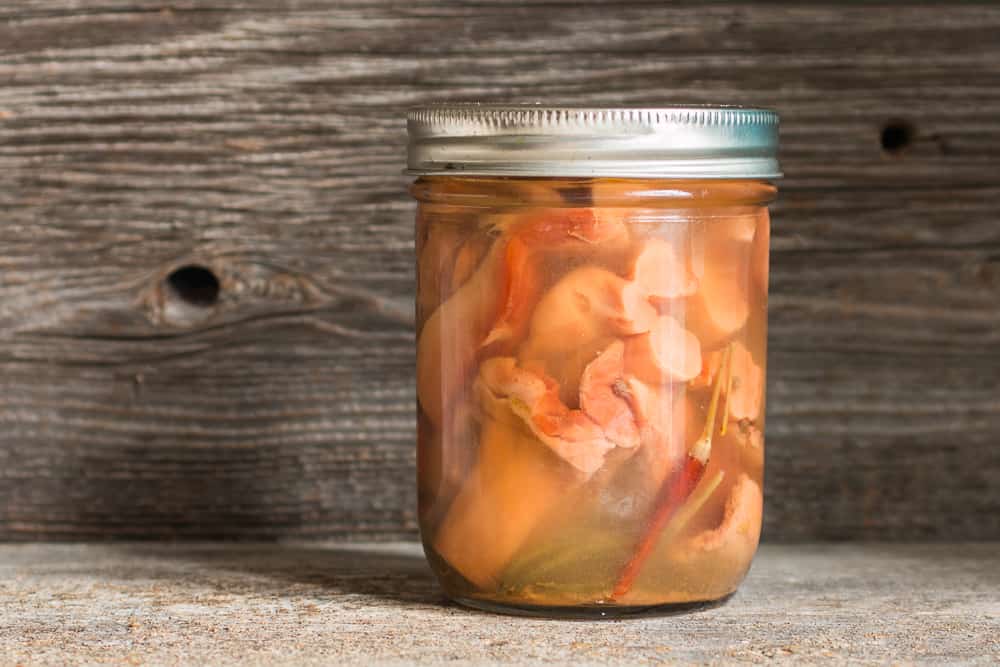
Once the mushrooms start to come up in the summer, chickens are some of the first you'll see. After going out and hunting over the course of the season though, they can almost get a little annoying. You pray for a nice patch of chanterelles or hedgehogs, but all you keep finding is chickens, and more chickens.
It's not really the chicken of the wood's fault though, I mean c'mon, they're bright orange and stick out like a sore thumb. I do my fair share of grumbling when I come across flushes of them that are past their prime, again and again.
Once in a great while you can find some that are really good. It's all about timing. When you get that good chicken, that really perfect one, unless you want to eat it every meal for a week, it's a good idea to make some pickles, which I'll get to, but first, lets talk about the perfect stage for eating.
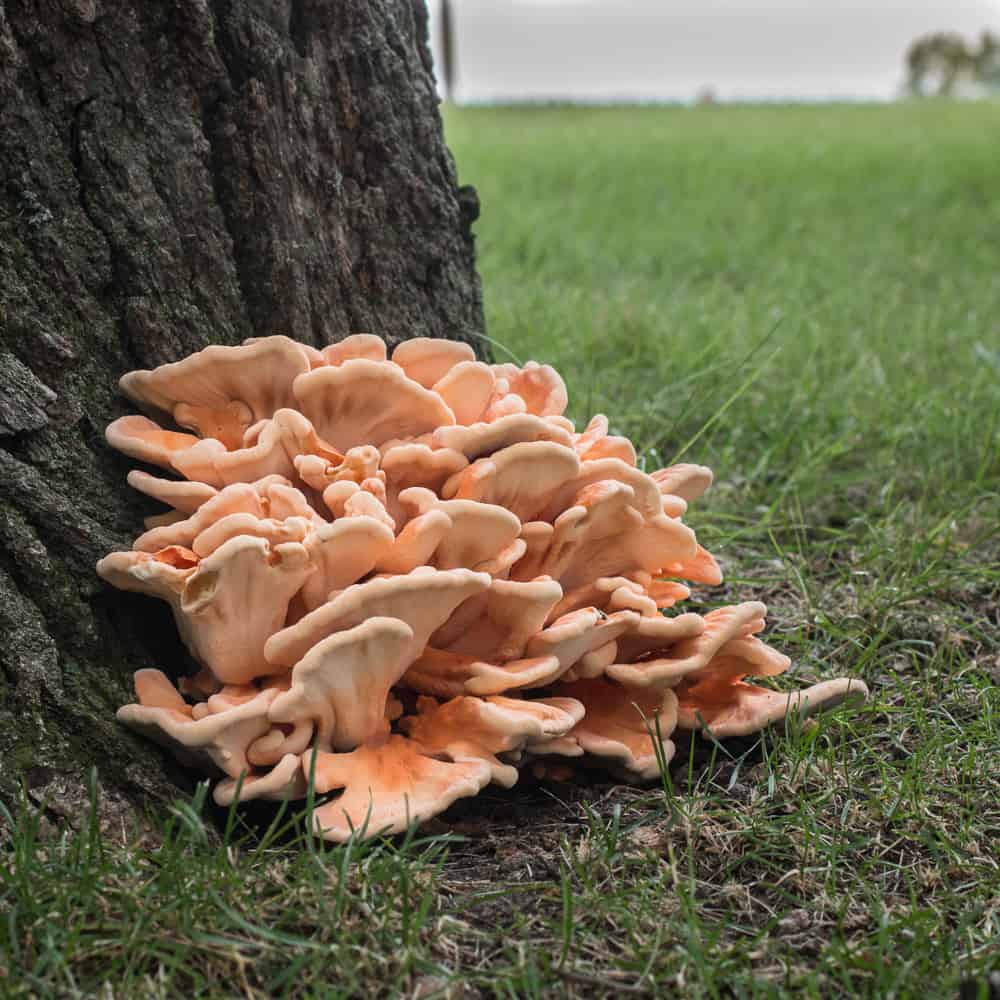
Chicken of the woods mushrooms grow pretty fast, and as they grow they get tough and leathery. Once in a while though, if you have a good eye, you might be able to spot some that are really young and just starting to pop out of the wood.
You might be tempted to let the chickens grow so that you can come back for a larger shroom later, but more often not, especially with chickens, they will be riddled with bugs before you know it, so my advice, is to take them while they're young and tender. Hen of the woods are similar.
Seriously, I beat this drum every year, but I just can't stress enough how important it is to get the youngest chicken of the woods that you can find. Older chickens just aren't the same, not in the slightest. Think of it like a garden vegetable that's too old: like woody fennel or lettuce that's gone to seed: everything has a perfect stage for harvesting, and with chickens, it's young, young, young.
Some people may say older chickens with pronounced shelf forms are edible, and they can be, depending, but more often than not, mature chickens, besides being riddled with worms, will be plenty chewy, a week later they'll be inedible shoe leather, and a week after that, like chewing bark.
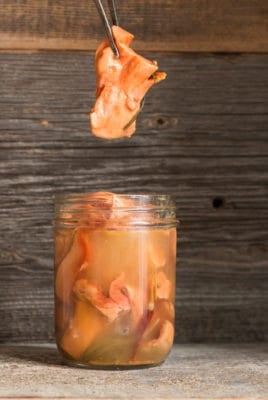
Next time you stumble upon some really young ones, try putting some up in pickles (the one pictured above fed sixteen people and made 1 qt of pickles.
The next thing to know is how I use these. Contrary to a lot of pickles, when I use these, they generally aren't being eaten out of a jar, they're getting warmed up gently, and spoon on top of something, maybe with a little butter and some of their liquid to make a light sauce, with a little chopped parsley or some fresh herbs.
The big reason to pickle wild mushrooms, especially the beautiful white pored chicken that was my model for this, is that pickling mushrooms is basically the best way to keep the texture as close to if they were fresh as possible.
You'll also notice I don't put sugar in my mushroom pickles. Putting sugar in mushroom pickles is a pet peeve of mine, just because its a pickle doesn't mean it has to have sugar, or assassinate the mushroom with vinegar, which most recipes do.
Give it a try the next time you find a nice one.
Related Posts
- Mushroom Conserve (Pickled Mushrooms)
- Japanese Fermented Muscaria Pickles
- Homemade Mushroom Jerky (Using a Dehydrator)
Pickled Chicken of the Woods Mushrooms
Ingredients
- 1 lb chicken of the woods preferably young and very tender
- 3 cups water
- 1.5 teaspoon salt
- 2 large cloves of garlic
- A few sprigs of fresh thyme
- Two dried bay leaves
- 1 cup of champagne or white wine vinegar
Instructions
- In a small stock pot, bring the water, salt, garlic and herbs to a simmer.
- Add the chicken of the woods and cook until they have released their juice and cooked through, about 5 minutes.
- Add the vinegar to the mixture, then pack pint canning jars full of the pickles. Pour the pickle liquid over the mushrooms and fill the jars leaving ½ an inch of headspace, then process the jars in a waterbath canner for 15 minutes.

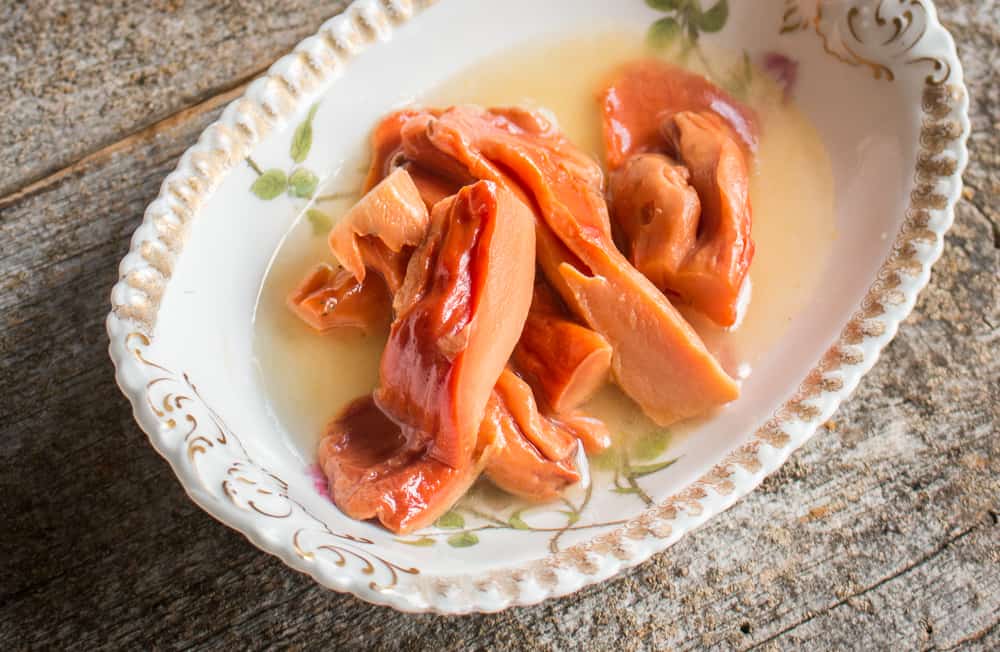
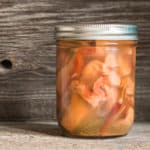
Kathleen
Just experienced pickled chicken of the woods.My older brother found your recipe and made a batch a few weeks ago. We really enjoyed them. Very good plain or on our sandwich.
Alan Bergo
Thanks Kathleen.
Julia
This recipe is perfect! I have savored last year’s pickled hens, and just found and pickled my first chicken for this year. Can’t wait to find and process more. Thank you!
Hillary
Hey Alan,
I made this today and had a lot of remaining brine left, like 2 1/4 cups. Do you usually have leftover? If so, I’m curious why not reduce the liquid amount, which would also concentrate the mushroom juices?
Thanks for all you do and share,
Hillary
Alan Bergo
Hillary, thanks for commenting, so, here's the deal. This is a recipe I use interchangeably for different polypores, and, chicken of the woods often has a widely variable water content compared to other popular ones like hens. The proportions here will always have a little liquid leftover, but 2 1/4 cups a lot. The vessel you decide to put them in can have some bearing on that, as well as how many jars. This should make 2 pint jars, and I typically use wide mouth. The age of the mushrooms can change how much water will fit in them a bit too, but is not as variable as the natural water they contain, which can be pronounced if they're picked after a rain, which I'm sure you know. The design of the proportions here is meant to accomodate chickens picked in varying stages of growth, so you should expect a little variability.
Any "goodness" from the mushrooms left in the brine is pretty negligeable, and they will continue to sit and release their own juices into the pickle as they sit, so don't worry about that. In time, to negate the variability of water in recipes like this, I may change the instructions to have people remove the mushrooms from the pot, and then measure the liquid, but that presents it's own complications as it's not how I typically make pickles, and people like things easier, rather than with extra steps. A little extra liquid is not a big deal in the scheme of things to me, but it's been on my mind.
Hope that's helpful, and let me know if you have any other questions.
Stacy
How long do they have to sit for after trying are done? And can these be eaten right out of the jar or do they need to be slightly cooked?
Alan Bergo
Stacy, you can try them right away if you like. They can be eaten straight from the jar, but should be refrigerated after opening.
Nancy
Hi I found what I think is a pale chicken if the woods. After reading up on your advice, this must be an old one. I’m wondering if I can varnish it and use as decoration and look for young version that will be more palatable.
I ferment and can so I was delighted to read up on your ideas. However, it is work so rather than to all the work for sub quality, can this giant be preserved for beauty?
Thank you.
Alan Bergo
Yes you can preserve it as a craft, but you'd want to treat it somehow to make sure it's not being eaten by larvae.
Melanie
Is it possible to ferment chicken of the woods? if so how would you approach doing so? avoiding the heating stages so as to no kill the beneficial bacteria? kindly Melanie
Alan Bergo
Hi Melanie. Yes, you can ferment wild mushrooms, and I should probably put a post up about it. Heres the skinny: since mushrooms don’t have as much water as something like, say cabbage, you’ll want to cover them in brine, depending on the ambient heat winter vs summer, for example, you should use a salt concentration between 3-5 % weight of salt to water. The mushrooms need to be completely submerged, and weighted down. Alternately, the easiest, and safest way, as well as with the least aroma, is to vacuum seal food with the same amount of salt by weight (I would use a higher concentration (5%) with wild mushrooms. For a slow ferment, you could also brine the mushrooms and keep them under refrigeration, in that case, the fermentation will be retarded greatly and move at a slower pace. With a lot of mushrooms, it will probably work best to blanch them in water first to ensure they hold their shape, and color, and also so they can be packed tightly in whatever fermentation vessel you’re using. I would also blanch them before hand if you plan on consuming the ferment raw.
Chris
After i make them, is it necessary to store them in fridge? Is't room temperature enough? I plan on making a lot and i dont have room in my fridge.
Alan Bergo
If the jar forms a seal from the ingredents being boiling hot when they go in the jar you're fine. If it doesn't seal, try warming it up and water bath canning.
Chris
Thank yoiu!
Chris
Thank you for aaaall the information!! Very helpful site!
Mike
Hi Alan - We have a giant tree stump in our backyard and to my surprise/delight I discovered a good haul of chicken of the woods growing on it a few days ago! This is my first time harvesting wild mushrooms, pretty exciting.
Anyway - unfortunately I did exactly what you suggested against. Sauteed up a small piece, was blown away, then became greedy and decided to wait a few more days so it could grow and I had a bigger harvest. Looks pretty clean though and little if any bug damage I could find. Now I have about 6.5 lbs in the fridge lol!
Is your recommendation to can only very young batches just bc of flavor or is it safety-related or something? Can I pickle what I have here or should I just sautee and freeze like I do when I find discounted baby bellas at the store? Thanks for any thoughts.
Mike
Sorry - also how long can I expect these to keep in the fridge fresh/raw?
Alan Bergo
That depends on if they have larvae. Even if they're past prime, mushrooms can last for a week or more in the fridge kept in a plastic bag with damp towels, and a few holes punched in for air, but their shelf life, at least in my area, depends on the presence of larvae. If the mushrooms are pristine and bug-free, you will be able to keep them for a while. If there is any presence of insects though, you have only a couple days at best. This is why I tell people to pick them young, more so than because of a tough texture, although it is important too. location also plays a big part here, for example, the species of chanterelles I pick in Minnesota are generally feasted on by larvae, so the shelf life can be short unless I get a really clean first flush. Chanterelles from the Pacific Northwest are generally bug free, and last much longer.
Patty VB
Well there are 5 pint jars in the pot. Can wait to taste them. How long do you recommend waiting?
Patty VB
Well there are 5 pint jars in the pot. Can’t wait to taste them. How long do you recommend waiting?
Alan Bergo
You're fine. Crack one open.
Evespower
Thank you so much for this recipe! I want to preserve, but sont want them tasting like pickles. I have pickled some with a 1:1 recipes and that's boring now. I'm excited to try this, but have to wait because I had to order friggin ph test strips online*sigh*
But I have found 5 5-8lb specimens this week and I have prepped and boiled in plain water to preserve consistency, now just waiting on papers to arrive
Alan Bergo
The amount of vinegar in the recipe is solid, and you will be fine just canning them, but I always like to tell people the proper way to do things. Also, I will say part of the reason these pickles taste good is because the mushroom's cooking juice is part of the pickling liquid. They'll be a little less interesting after blanching since some of the liquid has been removed, so maybe add some extra herbs or spices to kick things up a notch? Lemon peel is a great addition.
Marie
Awww man...yeah that juice smelled really good, but I thought it was poison of sorts and threw it out...frick!
Thanks again I'm going to try this with white wine vinegar bc I cant find champagne around here.
Matthew
Thank you for the pickling recipe for chicken of the woods.
Once pickled, how do I prepare them for eating? Are they now just a snack? Or can I cook them as I would fresh chicken of the woods and expect a similar taste?
Alan Bergo
They are much more than a snack. I warm them up and put them on anything I want. Warmed up and tossed in a bowl with a couple wild greens like chickweed or young amaranth and put on top of a piece of fish was a favorite at one restaurant I worked at. You can eat them out of the jar too, but I like to warm them up, since the flavors come alive a little more when they're warm.
John J. Iskierka
Allen, I was always taught to pressure can our mushrooms (honey mushrooms) Never tried the other types until we took Mike's Classes Is it ok to waterbath all mushrooms as long as I use the vinegar or should I stick with my extra salt and pressure cook w/o the vinegar? Does the vinegar carry over in the mushrooms much? Thanks, John
Love your new place.... Hope to make it down there again real soon.
Andrew
Alan, I'm concerned that your brine ratio isn't safe. Most books & Ag extensions recommend 5% vinegar and a 1:1 water/vinegar ratio to make a 2.5% brine. Also, using pickle/kosher/sea salt will prevent your brine from clouding.
Alan Bergo
Hi Andrew. Most run of the mill books on pickling give recipes for pickles that end up tasting aggressively like pure vinegar, which is what you will get if you use a 1:1 ratio of vinegar to water. Using such a strong amount of vinegar can obscure the flavor of the food you're trying to preserve.Following this recipe, even using slightly less vinegar, will give you a fine, safe result, especially if processed in a water bath. If the reader is unsure about safe PH levels, they should use a ph tester, making sure to achieve a level below 4.2.
I worked with the State of Minnesota's Health Department when they came into a restaurant I worked at to monitor the pickles we made in house we sold to the public. I can tell you that as long as the ph level is below 4.2, it doesn't matter what ratio you use, and that we definitely didn't use something as strong as a 1:1 ratio. Holding the pickles in a refrigerator is also a great choice, and I have kept mushrooms like this for a year or more seasoned to taste only slightly with vinegar and oil, they work great, but the cook needs to be versed in preservation techniques. Thanks for your interest.
Collin
This is helpful! I just found a stash of COWs I'd love to pickle. I know a person who feels that pH alone isn't a good indicator as pH can change with time as the brine and mushroom liquid mixes. What resources can I point her to to reassure her?
Steve Pendergast
Alan- Did the ramps in the spring and loved them. Have you ever used them in a martini? Excellent, I can tell you. I did 6 ibs of cows last night, and being a canning newcomer, is there a way to tell if the hermetic seal has taken hold? Also, do you age them in the fridge or dark cabinet?
thanks again and in advance.
Alan Bergo
Steve, you can easily tell if a hermetic seal has formed, press down on the lid of the canning jar, does it pop up and down? If so the seal is not formed, heat the ingredients, re-pack and process. Also try the easy no process hermetic seal method if you like, with this method you can fill the jars to the absolute brim, since there is no outside heat to cause explosions. Enjoy those mushrooms, I'm assuming you mean chicken of the woods?
Steve Pendergast
Alan, thanks. I have a hermetic seal. Now for the hard part, which is the wait! If the seal is good, do I need to refrigerate or not? I was referring to chicken of the Woods. Would you pickle the hedgehogs similarly? I really enjoy your website and thanks for making it so interesting.
Alan Bergo
Steve, when the hermetic seal is formed, there is no need for refrigeration post canning. After they jars of pickles are opened though, they must be refrigerated. As long as the mushrooms stay underneath their liquid, untouched by air, bacteria will not grow on the mushrooms and they are safe due to the lowPH of the liquid. If the amount of air in your jars increases since you are eating from the jar and you forget about the mushrooms in your fridge for a while, some mold may grow on the glass, this can be removed by rubbing down the jar occasionally with a paper towel moistened with vinegar.
Steve Pendergast
Alan- I must have been in a hurry. Just reread this and cows doesn't seem like a great acronym for chicken of the woods in hindsight!
Thanks for your help.